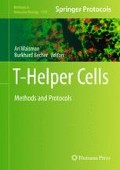Abstract
Mass cytometry is a form of flow cytometry based on single-cell mass spectrometry that uses monoisotopic elemental labels to probe individual cells. Reduced cross talk between channels and an ability to measure >30 independent cellular parameters make this an attractive approach for high-dimensional analysis of cellular phenotypes and function. Here, methods of using this approach for the analysis of human T cell surface markers and intracellular cytokines are described.
Access this chapter
Tax calculation will be finalised at checkout
Purchases are for personal use only
References
Bandura DR et al (2009) Mass cytometry technique for real time single cell multitarget immunoassay based on inductively coupled plasma time-of-flight mass spectrometry. Anal Chem 81(16):6813–6822
Bendall SC et al (2011) Single-cell mass cytometry of differential immune and drug responses across a human hematopoietic continuum. Science 332(6030):687–696
Krutzik PO, Nolan GP (2006) Fluorescent cell barcoding in flow cytometry allows high-throughput drug screening and signaling profiling. Nat Methods 3(5):361–368
Bodenmiller B et al (2012) Multiplexed mass cytometry profiling of cellular states perturbed by small-molecule regulators. Nat Biotechnol 30(9):858–867
Newell EW et al (2012) Cytometry by time-of-flight shows combinatorial cytokine expression and virus-specific cell niches within a continuum of CD8+ T cell phenotypes. Immunity 36(1):142–152
Newell EW et al (2013) Combinatorial tetramer staining and mass cytometry analysis facilitate T-cell epitope mapping and characterization. Nat Biotechnol 31(7):623–629
Newell EW, Lin W (2013) High-dimensional analysis of human CD8 T cell phenotype, function, and antigen specificity. Curr Top Microbiol Immunol 377:67–84
Jabbari A, Harty JT (2006) Simultaneous assessment of antigen-stimulated cytokine production and memory subset composition of memory CD8 T cells. J Immunol Methods 313(1–2):161–168
Betts MR et al (2003) Sensitive and viable identification of antigen-specific CD8+ T cells by a flow cytometric assay for degranulation. J Immunol Methods 281(1–2):65–78
Fienberg HG et al (2012) A platinum-based covalent viability reagent for single-cell mass cytometry. Cytometry A 81(6):467–475
Fuss IJ et al (2009) Isolation of whole mononuclear cells from peripheral blood and cord blood. In: Coligan JE et al (eds) Current protocols in immunology. Wiley, New York, NY, Chapter 7: p. Unit7 1
Yokoyama WM, Thompson ML, Ehrhardt RO (2012) Cryopreservation and thawing of cells. In: Coligan JE et al (eds) Current protocols in immunology. Wiley, New York, NY, Appendix 3: p. 3G
Leipold MD, Maecker HT (2012) Mass cytometry: protocol for daily tuning and running cell samples on a CyTOF mass cytometer. J Vis Exp 69:e4398
Linderman MD et al (2012) CytoSPADE: high-performance analysis and visualization of high-dimensional cytometry data. Bioinformatics 28(18):2400–2401
Qiu P et al (2011) Extracting a cellular hierarchy from high-dimensional cytometry data with SPADE. Nat Biotechnol 29(10):886–891
Acknowledgments
We thank members of the Mark Davis, Garry Nolan, and Holden Maecker labs for their contributions of information about mass cytometry theory, usage, and experiences with various monoclonal antibodies leading to the development of this protocol. We also thank the mass cytometry platform users at the Singapore Immunology Network for assistance in validating this method, especially members of the Gennaro De Libero lab. Core funding through the Singapore Immunology Network supported this work.
Author information
Authors and Affiliations
Corresponding author
Editor information
Editors and Affiliations
Rights and permissions
Copyright information
© 2014 Springer Science+Business Media New York
About this protocol
Cite this protocol
Newell, E.W., Yun, L.L. (2014). Mass Cytometry Analysis of Human T Cell Phenotype and Function. In: Waisman, A., Becher, B. (eds) T-Helper Cells. Methods in Molecular Biology, vol 1193. Humana Press, New York, NY. https://doi.org/10.1007/978-1-4939-1212-4_7
Download citation
DOI: https://doi.org/10.1007/978-1-4939-1212-4_7
Published:
Publisher Name: Humana Press, New York, NY
Print ISBN: 978-1-4939-1211-7
Online ISBN: 978-1-4939-1212-4
eBook Packages: Springer Protocols

